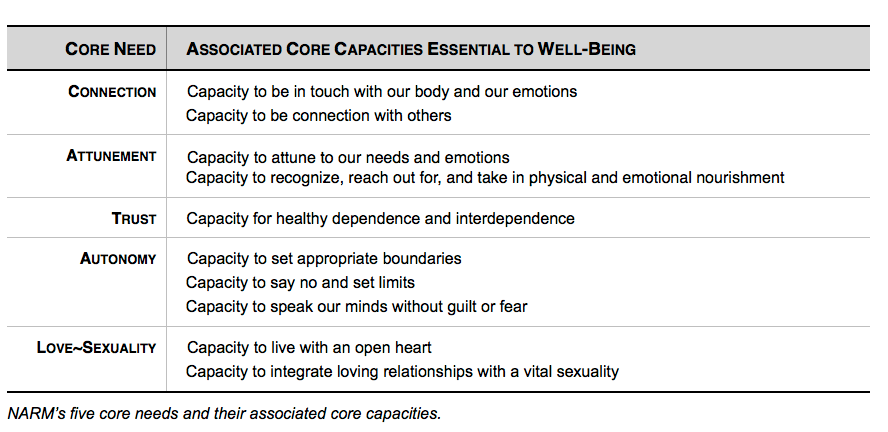What Happens When Core Developmental Needs Go Unmet In Childhood?
A Review of NeuroAffective Relational Model (NARM) "Survival Styles"
Part of what makes learning healthy boundaries challenging for someone people is that they don’t even realize they have a problem. Boundary wounding is a trauma symptom, but many people with wounded boundaries don’t even realize they’ve been traumatized. They may have an Adverse Childhood Experience (ACE) Score of zero and still have severe developmental trauma that causes wounded boundaries. That’s why I advocate so strongly for educating people about developmental trauma, which results when normal childhood development gets interrupted, either by often innocent mistakes made by our parents (who were usually boundary wounded themselves) or by growing up in unsafe cultural conditions.
Obviously, some boundary wounding may result from physical or sexual abuse or growing up in a war zone, or other obvious violations of our right to personhood and safety. Others happen much more subtly, through traumas that interrupt healthy childhood developmental stages. Our parents are supposed to be sensitive and attuned to our needs when we’re young, dependent, and fragile. When our caregivers are attuned, we feel safe, nurtured, loved, supported, and our nervous systems can relax. When we get our attunement needs met as one of the core developmental needs described by Laurence Heller, PhD in the NeuroAffective Relational Model (NARM) trauma healing method, we grow up able to know what we need and to recognize, reach out for, and take in the abundance that life offers. Sadly, too many of us did not get this need for attunement met. This pattern leads to a predictable constellations of trauma symptoms that make us vulnerable.
What are they? As described in Heller’s Healing Developmental Trauma, children have five core developmental needs- for connection, attunement, trust, autonomy, and healthy connection between love and sexuality- and that if any of these needs are not met, a series of behavioral patterns arise. When these core developmental needs are met, kids (and later adults) develop core capabilities.
When those needs are not met, we grow up with certain predictable trauma symptoms and behavioral patterns which NARM calls “Survival Styles”, which we may not even recognize as trauma symptoms, making it hard to get them treated. IFS practitioners may translate these survival styles into constellations of protectors and exiles. Let’s unpack the five Survival Styles- Connection, Attunement, Trust, Autonomy, and Love & Sexuality.
CONNECTION
The first year of life is supposed to be a time of normal, healthy symbiosis between the mother and infant, where boundaries blur and the baby cannot tell where mother stops and baby begins. This healthy symbiosis makes baby feel safe and connected, establishing a sense that intimacy is not only safe, it feels good and leads to core needs being met. Connection with the parent leads to a regulated nervous system that allows the infant to stay embodied, knowing that needs will get met and connection will alleviate distress if it occurs.
If the need for CONNECTION is not met:
-lack of affect
-feeling shame about needing anything from anyone
-communicate intellectual or spiritual superiority
-relate to others who did not get connection needs met and don’t challenge their need for personal space
-use interpersonal distancing as a substitute for adequate boundaries
-withdraw in emotionally disturbing situations
-tend to relate in an intellectual rather than a feeling manner
-seldom aware that they are out of touch with their bodies
-fear both being alone and being overwhelmed by others
-feel like a frightened child in an adult world; do not know how to deal with or appropriately manipulate their environment
-exaggerated fear of death and disease
-fear their own impulses, particularly anger
-fear groups and crowds
-intense ambivalence: deepest desire for contact is also the deepest fear
-yearn to fill emptiness and fear fulfillment at the same time
-strong need to control self, environment and other people
-difficulty tolerating intimacy
-want to know reason why; transcendentally or intellectually oriented
-because of their failure to embody, often have access to esoteric spiritual states
-drawn to therapies, meditation, and spiritual movement that reinforce dissociation
Those whose connection needs don’t get met have shame-based identifications: shame at existing, feeling like a burden, feeling of not belonging. They also may have pride-based identifications: pride in being a loner, pride in not needing others, pride in not being emotional. When these babies grow up, they may be particularly attracted to spiritual practices and activities, since it’s easy for them to traverse dimensions, having never fully embodied in this grounded, earthly dimension. They may live in the vicinity of their body but struggle mightily with embodiment. They may also exhibit neurodivergent tendencies, which can make this kind of developmental trauma difficult to distinguish from autism.
COMMON PHYSICAL & MENTAL HEALTH SYMPTOMS for those whose CONNECTION needs go unmet:
-Migraines
-ADHD
-Colic
-Dissociation
-Digestive problems
-Irritable Bowel Syndrome
-Environmental sensitivities
-Asthma
-Depression
-Fibromyalgia
-Chronic fatigue
-Scoliosis
-Allergies
-Anxiety
-Panic attacks




